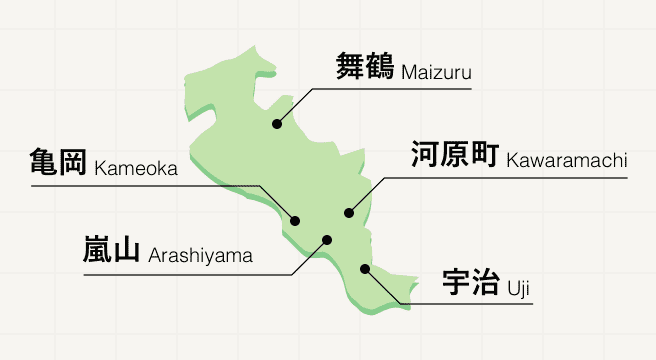Other Historic Site/Building Spots in Kyotanabe / Kizugawa Area
Area
-
-
Kyoto
-
-
Kyoto
-
-
Kyotanabe / Kizugawa
-
- All areas
- Around Gion
- Around Kiyomizu-Dera Temple
- Around Okazaki
- Around Ginkaku-Ji Temple
- Ichijo-ji Temple / Shugakuin
- Around Fushimi Inari
- Around Kyoto Station
- City Center
- Around Kyoto Imperial Palace
- Around Nishijin
- Around Kamigamo
- Around Kinkaku-Ji Temple
- Uzumasa / Hanazono
- Arashiyama / Sagano / Takao
- Around Mt. Hiei
- Ohara / Kurama / Kifune
- Katsura / Nishiyama
- Yamashina / Daigo
- Around Fushimi
- Around Uji
- Joyo / Yawata
- Kyotanabe / Kizugawa
- Kameoka / Nantan
- Maizuru / Miyazu
-
Kyotanabe / Kizugawa

Category


-
- Warai Botoke (Laughing Buddha)
- Travel / Tourism
- Kyoto Kizugawa-shi Kamocho Iwafune
- The Tono area of eastern Kizugawa city has a large number of stone Buddhas and towers. One of those is a gently smiling statue of the Amitabha triad.
-
- Three Stone Buddhas in the Woods
- Travel / Tourism
- Kyoto Kizugawa-shi Kamocho Higashi Sho
- This stone statue of the Magaibutsu was carved in 1262 by Tachibana Yasunawa, and along with the Kubikirijizo (Higashio Amitabha Sekiganbutsu) is the oldest in Tono. The center of the boulder features the Jizobosatsu, with Amitabha Nyorai on the left, and the 11-faced Kannon on the right, creating a very unusual stone-buddha triptych. Legend says this was the honzon (principal object of worship) of the old Jodo-in sub-temple.
-
- Kunikyu Palace Site (Yamashiro Kokubunji Temple Ruins)
- Travel / Tourism
- Kyoto Kizugawa-shi Kamocho Reihei
- This is the site of Kunikyo, once designated the capital of the country; along with the ruins of the ancient Yamashiro Kokubunji Buddhist temple. There are very few places in Japan where two important historical landmarks are located on the same site, and it has been designated a National Historic Site. The Yamashiro Kokubunji was a state-sponsored temple built on the site of Kunikyo, which served as the capital of the nation for around five years during the distant Tenpyo era, on the order of Emperor Shomu after its status as capital was downgraded; the Council Hall of the Kunikyu Palace was used as the main temple. The area around the site is known for flower viewing and boasts beautiful cherry blossoms in spring; and buckwheat flowers, red spider lilies, and common cosmos from late summer through fall.
-
- Fujiwara no Momokawa Oyakehaka
- Travel / Tourism
- Kyoto Kidugawashi Saganaka Shironishi
-
- Diva Kawarakamaato
- Travel / Tourism
- Kyoto Kidugawashi Ichisaka Suiboshi
-
- Izumishikibu grave
- Travel / Tourism
- Kyoto Kidugawashi Kidu Tonoshiro
-
- Goryeo Teraato
- Travel / Tourism
- Kyoto Kidugawashi Yamashirochoukamikoma Komadera
-
- Inooka Kurumazuka Ancienct Burial Mound
- Travel / Tourism
- Kyoto Kyotanabe-shi Inooka Nishihara
-
- Sakurai Ancienct Burial Mound
- Travel / Tourism
- Kyoto Kyotanabe-shi Inooka Nakamine
-
- Prince Mochihito your grave
- Travel / Tourism
- Kyoto Kidugawashi Yamashirochoukabata Kaminoki
-
- Otsukayama Ancienct Burial Mound
- Travel / Tourism
- Kyoto Kizugawa-shi Yamashirocho Tsubai Mikai
-
- Tachibana no Moroe Oyakehaka
- Travel / Tourism
- Kyoto Tsudukigunidechou Ide
Kyoto Areas

Its wooden tea houses, shuffling geisha, and spiritual sights have seen Kyoto hailed as the heart of traditional Japan, a world apart from ultramodern Tokyo. Despite being the Japanese capital for over a century, Kyoto escaped destruction during World War II, leaving behind a fascinating history which can be felt at every turn, from the fully gold-plated Kinkakuji Temple down to traditional customs such as geisha performances and tea ceremonies, which are still practiced to this day.
Best of Kyoto
Search by Region
-
- Hokkaido / Tohoku
- Hokkaido
- Aomori
- Iwate
- Miyagi
- Akita
- Yamagata
- Fukushima
-
- Kanto
- Ibaraki
- Tochigi
- Gunma
- Saitama
- Chiba
- Tokyo
- Kanagawa
-
- Koshinetsu / Hokuriku
- Niigata
- Toyama
- Ishikawa
- Fukui
- Yamanashi
- Nagano
-
- Tokai
- Gifu
- Shizuoka
- Aichi
- Mie
-
- Kinki
- Shiga
- Kyoto
- Osaka
- Hyogo
- Nara
- Wakayama
-
- Chugoku
- Tottori
- Shimane
- Okayama
- Hiroshima
- Yamaguchi
-
- Shikoku
- Tokushima
- Kagawa
- Ehime
- Kochi
-
- Kyushu / Okinawa
- Fukuoka
- Saga
- Nagasaki
- Kumamoto
- Oita
- Miyazaki
- Kagoshima
- Okinawa














